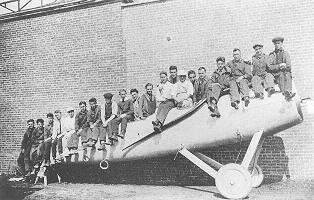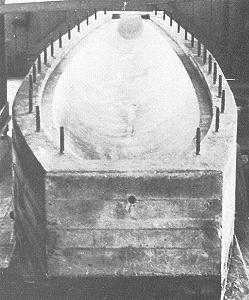Molded
Plywood Construction

Workers from the LWF factory in College Point,
Queens, New York City, demonstrate the strength of
the laminated wood fuselage of the Model V.
One of the earliest examples
of molded wood fuselages was the LWF Engineering Company
in College Point, Queens, New York City. The LWF company
was formed in 1915 by Edward Lowe, Jr., Charles Willard,
and Robert Fowler, with each member contributing the
initial of his surname to form the company name. The
chief asset of the company was the "laminated
wood fuselage" developed by Charles Willard.
After the pioneering founders had been forced out
the company by large financial interests, the legend
was promoted that LWF stood for Laminated Wood Fuselage.
The only surviving example of the LWF Model V is in
the National Technical Museum in Prague, Czech Republic.
The Model V was used by the early Czechoslovakian
Air Force in 1919.

The Loughead Aircraft Manufacturing Company's
bid for "a poor man's airplane" was the
Loughead S-1, designed by Jack Northrop. The fuselage
was molded plywood.
Another application of molded
plywood construction was used by Jack Northrop in
the construction of the Loughhead S-1. For the S-1.
They used a 21-foot-long concrete mold. In this mold
were placed three thicknesses of spruce plywood strips,
alternately laid, and well saturated with casein glue.
Once the strips were in position, the mold was covered
with a rubber bag and then a cover was bolted to the
bottom mold. The rubber bag inside was inflated and
pressure was maintained for twenty-four hours. The
half shells produced could be joined, making clean,
smooth, bullet like fuselages.
The S-1 was a distinct departure
from pioneer and wartime aircraft. Northrop's experiments
resulted in a unique cigar-shaped, streamlined fuselage
that was of monocoque (French for "single shell")
construction, in which strength comes from the outside
skin rather than internal bracing. Northrop, Stadlman,
and the Lougheads devised and patented a process to
make molded plywood monocoque fuselage shells (US
Patent #1,425,113, August 8,1922).

Concrete mold in which monocoque wooden shell of
the S-1 Loughead sport biplane of 1919 was formed.
Composite
Materials

Various composite materials are used in structures
such as the Boeing 777 because of their strength,
and weight savings. Composites also offer resistance
to fatigue, corrosion and impact damage.
Composites are different
from metals. They are combinations of materials differing
in composition or form. The constituents retain their
identities in the composites and do not dissolve or
otherwise merge completely into each other although
they act together. Reinforced concrete is an excellent
example of a composite structure in which the concrete
and steel still retain their identities. The steel
bars carry the tension loads and the concrete carries
the compression loads. In aircraft construction the
term composite structures refers to fabric resin combinations
in which the fabric is embedded in the resin but still
retains its identity.
Advanced composite materials consist
of new high strength fibers embedded in an epoxy matrix.
These composites provide for major weight savings
in airplane structures since they have high strength
to weight ratios. When replacing aluminum structure
with graphite/epoxy composite weight reductions of
20% or better are possible. Weight reduction is the
greatest advantage of composite material and is one
of the key items in decisions regarding its selection.
other advantages over conventional structure include
its high corrosion resistance and its resistance to
damage from cyclic loading (fatigue).
The major disadvantage of using advanced
composite materials in airplane construction is the
relatively high cost of the materials.
Composite Hybrids: Hybrids are made
by the addition of some complementary material such
as fiberglass or kevlar to the basic carbon fiber/epoxy
matrix. The added materials are used to obtain specific
material characteristics such as greater fracture
toughness and impact resistance, and should be considered
for areas subject to foreign object damage. The addition
of carbon / epoxy to fiberglass structure is used
to provide additional stiffness.